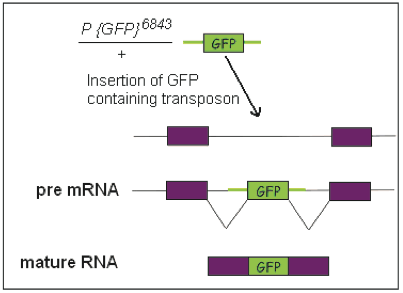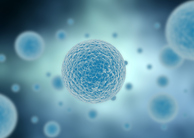From Discussions VOL. 5 NO. 1A Genome Wide Search for Proteins that Control the Balance Between Proliferation and Differentiation in the Drosophila Ovary, an in vivo model System
IN THIS ARTICLE
KEYWORDS
AbstractUnderstanding how progenitor cells stop proliferating and enter a differentiation pathway is a fundamental question in cancer and stem cell research today. The long term goal of this study is to identify proteins required for the transition between proliferation and differentiation in the Drosophila ovary, which is a model system for studying stem cells and tumor formation. To meet this objective, gene trap technology was used, which involves the insertion of green fluorescence protein (GFP) via a P element transposon called P{GFP}. When P{GFP} is inserted into an intron, it ̳traps' the protein and functions as an exon, fusing the endogenous protein with GFP. This GFP fusion protein allows for examination of the expression pattern of the trapped gene in vivo. Transgenic lines that contain single random P{GFP} insertions are identified using our genetic screening. Live ovaries were screened to identify patterns of GFP expression in the transgenic lines. Thus far, over 300 lines were screened and two were identified that express GFP. By searching for genes that are highly expressed in tumor cells, the probability of trapping interesting genes was increased in proliferating or differentiating cells. High resolution microscopy was used to determine if GFP expression is occurring in stem cells or differentiating cells and also to compare expression in wild type ovaries to tumorous ovaries. Inverse PCR and sequencing was used to identify the endogenous gene in which the GFP insertion has occurred. Knowing the identity of the trapped protein will lay the foundation for understanding the role of the protein in the pathway that controls the choice between proliferation and differentiation. INTRODUCTIONStem cells are undifferentiated cells that undergo asymmetric division to produce a daughter cell that remains a stem cell and proliferates, and a progenitor cell, whose progeny differentiate into a defined cell type. Progenitor cells undergo limited cell division in the time between leaving the stem cell niche and beginning differentiation, and can sometimes 'de-differentiate' to regain the stem cell's self renewing properties. The regaining of stem cell-like self-renewing properties is thought to be a characteristic of tumorous cells. The model used for the study of stem cells and tumor development is the Drosophila melanogaster ovary (Figure 1, provided by Johnie Chau). The ovary consists of 15-20 tubes called ovarioles. Two or three germline stem cells (GSCs) are located in the germarium, the anterior end of the ovariole. The daughter cell that remains in contact with the somatic cap cells at the tip of the germarium remains a stem cell and the other daughter cell, the progenitor or cystoblast (CB) cell, undergoes cell division. Figure 1. Our in vivo model system: the Drosophila ovary. The fly has proven to be a good model for gene identification and function studies. The simple anatomy of the fly germline allows for unambiguous identification of stem cells and their progeny in vivo. Also, results can be directly applied to human stem cell biology because the stem cell system appears to be conserved between flies and vertebrates. The genetic screen that was carried out is designed around two main points. First, control of germ cell fate decisions occurs at both the transcriptional and post translational level, and the study therefore uses ̳protein trapping' rather than expression arrays. Second, it is known that the proliferation/differentiation decision is made by stem cell-like cells as they leave the stem cell niche, but it is impossible to screen for genes expressed specifically in these cells because there are only a few in each ovariole at any given time. We screen instead for genes expressed in the snf148 tumor cells, as studies conducted in Dr. Salz's lab indicate that snf148 tumors are rich in stem cell-like cells arrested in an intermediate stage of development. By comparing GFP expression in tumorous and wild types ovaries, lines that express GFP specifically in these arrested, intermediate cells but not differentiating cells can be identified. Proteins that are ectopically expressed in tumor cells may be coded by genes that must be silenced in order for differentiation to proceed. That is, these genes may be responsible for the continued proliferation in tumor cells, and further studies will show how exactly these genes function in the proliferation/differentiation decision. To identify genes expressed in snf tumors, a collection of lines that contain single, random insertions of GFP were generated and screened. The screen is based on other successful models that used the P-element based protein trap transposon called P{GFP}, which contains an artificial exon encoding GFP flanked by splice site acceptor and donator sequences (Morin, X., R. Daneman, M. Zavortink, and W. Chia, 2001). It functions as an exon when inserted into an intron fusing the endogenous protein with GFP. P{GFP} can also function as an enhancer/gene trap and in most cases, GFP expression accurately reproduces the developmental expression pattern of the trapped gene (Buszcak M, Paterno S, Lighthouse D, Bachman J, Planck J, et al., 2007). The process of gene trapping is shown in Figure 2, provided by Dr. Salz. Other researchers in Dr. Salz's lab had already identified two lines that are expressed in the intermediate cells, and more lines expressing GFP are being trapped and identified using the screen. Figure 2. Trapping genes with a GFP exon.
Suggested Reading from Inquiries Journal
Inquiries Journal provides undergraduate and graduate students around the world a platform for the wide dissemination of academic work over a range of core disciplines. Representing the work of students from hundreds of institutions around the globe, Inquiries Journal's large database of academic articles is completely free. Learn more | Blog | Submit Latest in Biology |

















